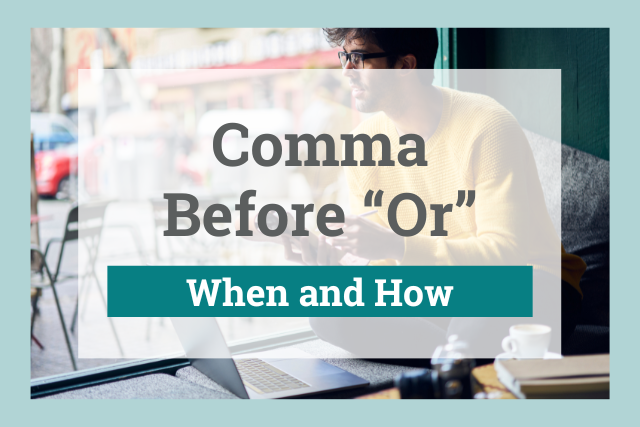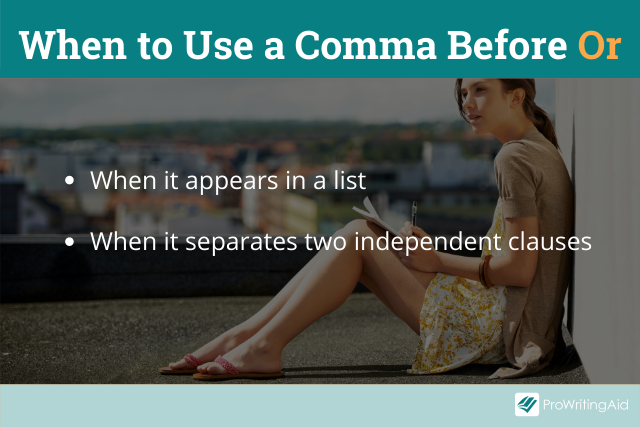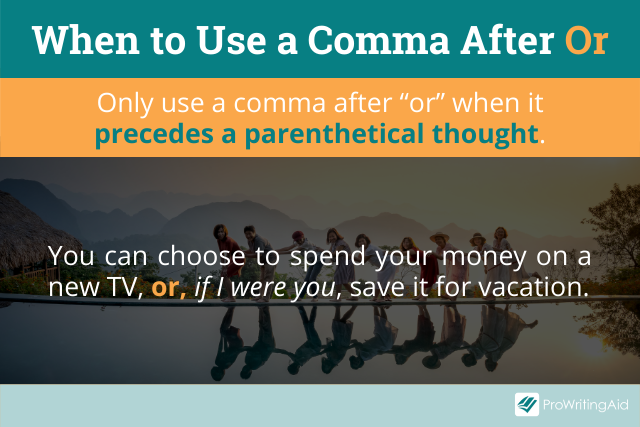
Learning rules for using commas with conjunctions can be difficult. Or is an especially tricky word when it comes to commas because it can be a coordinating conjunction, subordinating conjunction, or appear in a list.
Always place a comma before the word or when it connects two independent clauses. You can also choose to use a comma before or in a list.
Today, we will dive deeper into the rules for using a comma with or and look at some examples.
Do You Put a Comma Before Or?
To know whether to use a comma before or, you must first understand the difference between independent clauses and dependent clauses.
An independent clause expresses a complete thought. In other words, an independent clause can function as a complete, independent sentence.
A dependent clause “depends” on having an independent clause attached to it. It does not express a complete thought and therefore cannot stand on its own as a sentence.
Sometimes, we connect two independent clauses. We can do this with either a semicolon in place of a period, or we can use a comma and a coordinating conjunction.
There are seven main coordinating conjunctions: for, and, nor, but, or, yet, so. You can use the acronym FANBOYS to remember them.
If you are connecting an independent clause to a second independent clause with or, you must use a comma before or. This rule applies to all coordinating conjunctions.
Here’s an example:
- We can go to Taco Bell for dinner, or we can eat at home.
You can see that this sentence has two independent clauses joined by or. Both clauses can stand alone as complete sentences, so we know they are independent.
However, sometimes we combine an independent clause with a dependent clause. We use subordinating conjunctions to do this. There are dozens of subordinating conjunctions, including or.
When or is connecting a dependent clause to an independent clause, do not use a comma before or.
Here’s an example of or acting as a subordinating conjunction:
- We can go to Taco Bell for dinner or eat at home.
“Eat at home” is not a complete thought, so it’s a dependent clause. Therefore, we didn’t place a comma before or in this example.

Oxford Comma Before Or in a List
You can also use a comma before or when it appears in a list. The Oxford comma, or serial comma, is a comma before a conjunction in a list. A serial comma is optional but not required.
Here is an example of how you can choose to use a serial comma:
With serial comma: Would you like your eggs scrambled, poached, or over-easy?
Without serial comma: Would you like your eggs scrambled, poached or over-easy?
Both are correct. Whether you use the Oxford comma comes down to preference or your style guide if you have one.
The important thing is to be consistent when you do or don’t use Oxford commas; avoid switching back and forth. You can check the consistency of your comma usage in ProWritingAid’s Consistency Report.

Do You Put a Comma After Or?
We don’t typically use commas after or. The only situation where you might use a comma after or is when or precedes a parenthetical phrase.
When we set parenthetical phrases apart with commas, we place a comma before and after them.
Here’s what this might look like:
- You can choose to spend your money on a new TV, or, if I were you, save it for a vacation.
“If I were you” is a parenthetical thought. We could remove it without affecting the meaning of the sentence. This is the only time when you would use a comma after or.

Comma Before Or and After Or Examples
Let’s check out some more examples of when you should use a comma before or when it acts as a coordinating conjunction.
- My unpredictable boss might fire me in the meeting, or he will give me a raise.
- Should we go to Mexico this year, or should we wait and go to Europe next year?
- The student might go to a university in New York, or she might choose to take a gap year.
- I might break up with him this weekend, or he might agree to go to couples’ counseling.
- Should I wear the white dress, or should I go shopping for a new outfit?
- The doctor could have bad news, or the test results might come back negative.
Now, here are some more examples of how to use a serial comma before or:
- She wants to attend UCLA, Penn State, or Harvard for college.
- You can choose between strawberry shortcake, apple pie, tiramisu, or cheesecake for dessert.
- I would love to visit Japan, Thailand, or South Korea when I travel to Asia next.
- Of the following Marvel superheroes, do you prefer Black Widow, Captain Marvel, or Scarlet Witch?
- The hiring committee couldn’t decide between to the Yale graduate, the Air Force veteran, or the former teacher.
- The culprit was either the new puppy, the sticky-fingered toddler, the troublesome cat, or the hyper second-grader.
Finally, here are a few more examples of using a comma after or when it precedes a parenthetical phrase:
- We can focus on Instagram marketing or, if you think it would be better, TikTok marketing for this quarter.
- I can make spaghetti for dinner, or, if it sounds better, we can grab burgers.
- She might stay local, or, despite her parents’ objections, she might take the job in Spain.
Remember to only use a comma before or when it separates two independent clauses or when it’s in a list.
For more help getting your comma usage correct, you can check your writing with our free grammar checker.


